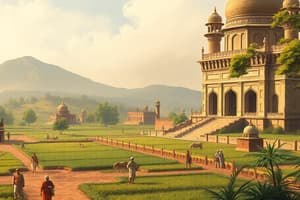Podcast
Questions and Answers
What was the primary role of the zamindars in the zamindari system?
What was the primary role of the zamindars in the zamindari system?
- To improve agricultural practices
- To produce food crops
- To provide loans to farmers
- To collect revenue from farmers (correct)
Commercialization of agriculture led farmers to focus primarily on food crops.
Commercialization of agriculture led farmers to focus primarily on food crops.
False (B)
What was one significant reason for low productivity in Indian agriculture during the colonial period?
What was one significant reason for low productivity in Indian agriculture during the colonial period?
Lack of irrigation facilities
The zamindari system led to the transfer of ownership rights from farmers to __________.
The zamindari system led to the transfer of ownership rights from farmers to __________.
Match the following terms with their descriptions:
Match the following terms with their descriptions:
What was the literacy rate during the colonial period?
What was the literacy rate during the colonial period?
The female literacy rate during the colonial period was approximately 7%.
The female literacy rate during the colonial period was approximately 7%.
What was the infant mortality rate during the colonial period?
What was the infant mortality rate during the colonial period?
The average life expectancy during colonial rule was as low as __________ years.
The average life expectancy during colonial rule was as low as __________ years.
Match the following sectors with their description of employment percentage:
Match the following sectors with their description of employment percentage:
How many years is the current overall life expectancy in India?
How many years is the current overall life expectancy in India?
The majority of the working population in India was engaged in industrial sectors at the time of independence.
The majority of the working population in India was engaged in industrial sectors at the time of independence.
What does the term 'occupational structure' refer to?
What does the term 'occupational structure' refer to?
What was the primary export of India during the colonial period?
What was the primary export of India during the colonial period?
India had a favorable trade balance during British colonial rule.
India had a favorable trade balance during British colonial rule.
What caused the economic decline in India during British rule?
What caused the economic decline in India during British rule?
During colonial rule, India was primarily an exporter of __________ and an importer of finished goods.
During colonial rule, India was primarily an exporter of __________ and an importer of finished goods.
Match the following demographic indicators with their significance:
Match the following demographic indicators with their significance:
What was a major consequence of the high birth and death rates during the colonial period?
What was a major consequence of the high birth and death rates during the colonial period?
The opening of the Suez Canal benefited India by increasing trade with various countries.
The opening of the Suez Canal benefited India by increasing trade with various countries.
What was the approximate birth rate in India during the colonial period?
What was the approximate birth rate in India during the colonial period?
What was the main reason for the decline of Indian handicraft industries during the colonial period?
What was the main reason for the decline of Indian handicraft industries during the colonial period?
The introduction of a discriminatory tariff policy favored Indian handicrafts over British manufactured goods.
The introduction of a discriminatory tariff policy favored Indian handicrafts over British manufactured goods.
What impact did rainfall variability have on agricultural output during the colonial period?
What impact did rainfall variability have on agricultural output during the colonial period?
The British aimed to reduce India to a mere exporter of __________ to their industries.
The British aimed to reduce India to a mere exporter of __________ to their industries.
Match the following due to colonial rule with their effects:
Match the following due to colonial rule with their effects:
What was a significant factor contributing to the low contribution of the industrial sector to India's GDP?
What was a significant factor contributing to the low contribution of the industrial sector to India's GDP?
The growth rate of the industrial sector during colonial rule was remarkably high.
The growth rate of the industrial sector during colonial rule was remarkably high.
What effect did capital goods industries have on industrialization in India during the colonial period?
What effect did capital goods industries have on industrialization in India during the colonial period?
Study Notes
Zamindari System
- The Zamindars were responsible for collecting revenue from farmers and paying it to the British East India Company.
- The Zamindari system led to the transfer of ownership rights from farmers to the Zamindars.
Commercialization of Agriculture
- Commercialization of agriculture led farmers to focus primarily on food crops, neglecting other crops and hindering diversification.
Low Productivity in Colonial Agriculture
- One significant reason for low productivity in Indian agriculture during the colonial period was the lack of investment in infrastructure and technology.
Demographic Indicators
- The literacy rate during the colonial period was very low.
- The female literacy rate during the colonial period was approximately 7%.
- The infant mortality rate during the colonial period was high.
- The average life expectancy during colonial rule was as low as 25 years.
Occupational Structure
- The term 'occupational structure' refers to the distribution of the working population across different sectors of the economy.
- The majority of the working population in India was engaged in the agricultural sector at the time of independence.
Economic Decline During Colonial Rule
- India had an unfavorable trade balance during British colonial rule, as it was exporting raw materials and importing finished goods.
- The economic decline in India during British rule was caused by various factors including exploitation of resources, suppression of Indian industries, and a discriminatory economic policy.
Birth and Death Rates
- The high birth and death rates during the colonial period resulted in a high rate of population growth.
Impact of Rainfall Variability
- Rainfall variability had a significant impact on agricultural output during the colonial period, leading to frequent famines.
Industrial Sector
- The growth rate of the industrial sector during colonial rule was low.
- A significant factor contributing to the low contribution of the industrial sector to India's GDP was the lack of investment in capital goods industries.
- The presence of capital goods industries would have accelerated industrialization by enabling the production of machinery and equipment.
Trade and Export
- India was primarily an exporter of raw materials and an importer of finished goods during colonial rule.
- The British aimed to reduce India to a mere exporter of raw materials to their industries.
Suez Canal
- The opening of the Suez Canal benefited India by increasing trade with various countries.
Decline of Indian Handicrafts
- The decline of Indian handicraft industries during the colonial period was mainly due to competition from British manufactured goods.
Colonial Rule Effects
- British policies led to the decline of Indian industries, while promoting the growth of British industries.
- These policies led to the economic exploitation of India's resources, which benefited Britain.
- The introduction of a discriminatory tariff policy favored British manufactured goods over Indian handicrafts.
- The colonial rule led to a shift in India's economic structure, where agriculture became the dominant sector.
Life Expectancy
- The current overall life expectancy in India is more than 70 years.
Studying That Suits You
Use AI to generate personalized quizzes and flashcards to suit your learning preferences.
Related Documents
Description
Explore the impact of the Zamindari system on Indian agriculture, including the commercialization of cash crops and low productivity levels. This quiz delves into how farmers were affected by colonial policies and the economic dynamics of the land tenure system. Test your knowledge about this crucial period in Indian agricultural history.




